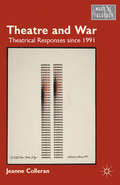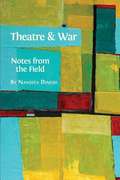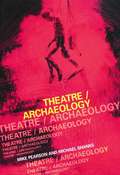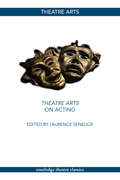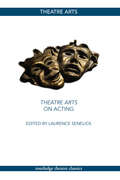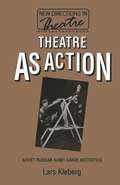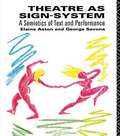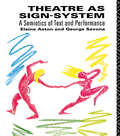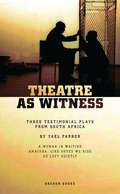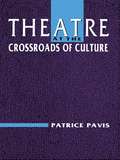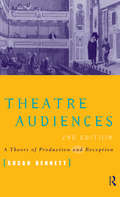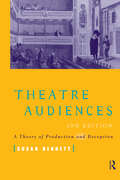- Table View
- List View
Theatre and Voice (Theatre And)
by Konstantinos ThomaidisHow can we rethink the importance of voice in performance? How can we understand voice simultaneously as music and text, as sound and body, or as both personal and political? This book explores voice across genres, media and cultures, inviting the reader to reassess established ways of analysing, enjoying and listening to voice. Using a wide range of case studies integrated with critical and philosophical frameworks, it makes audible the multiple ways in which voice contributes to how we perform identities. From opera and musical theatre to live art and immersive audio walks, Konstantinos Thomaidis presents voice as plural, elusive and ripe for reinvention.
Theatre and Voice (Theatre And)
by Konstantinos ThomaidisHow can we rethink the importance of voice in performance? How can we understand voice simultaneously as music and text, as sound and body, or as both personal and political?This book explores voice across genres, media and cultures, inviting the reader to reassess established ways of analysing, enjoying and listening to voice. Using a wide range of case studies integrated with critical and philosophical frameworks, it makes audible the multiple ways in which voice contributes to how we perform identities. From opera and musical theatre to live art and immersive audio walks, Konstantinos Thomaidis presents voice as plural, elusive and ripe for reinvention.
Theatre and War: Theatrical Responses since 1991 (What is Theatre?)
by J. ColleranHow has the media since the First Gulf War altered political analysis and how has this alteration has in turn affected socially-critical art? Colleran examines more than forty plays, many written in direct response to the 1991 war in Iraq as well as to the 9/11 attacks and the retaliatory actions in Iraq and Afghanistan.
Theatre and War: Notes From The Field
by Nandita DineshNandita Dinesh places Kipling’s "six honest serving-men" (who, what, when, where, why, how) in productive conversation with her own experiences in conflict zones across the world to offer a theoretical and practical reflection on making theatre in times of war. This timely and important book weaves together Dinesh’s personal narrative with the public story of modern conflict, illustrating as it does, the importance of theatre as a force for ethical deliberation and social justice. In it Dinesh asks how theatre might intervene in times and places of conflict and how we might reflect on such interventions. In pursuit of answers, Theatre and War adopts the methods of auto-ethnography, positioning the theatrical practitioner at the heart of conflict zones in northern Uganda, Guatemala, Northern Ireland, Mexico, Rwanda, Kenya, Nagaland, and Kashmir. No longer a detached observer, the researcher and practitioner has to be able to meld theory with practice; to speak to ‘doing’, without undervaluing the importance of ‘thinking about doing’. Each chapter approaches the need for a synthesis of theory and practice by way of a term of inquiry―Why, Where, Who, What, When―and each is equipped with a set of unflinchingly honest field notes that are designed to reveal some of the ‘hows’ from the author’s own repertoire: questions and issues that were encountered during her own theatrical undertakings, along with first hand reflection on the complexities, potential, and challenges that attended her global work in community theatre. Within these notes are strategies that give the reader a practical insight into how the discussion might find its footing on the ground of war. The range and scope of this book make it required reading for those interested in theatre―practitioners, researchers, and students alike—as well as those seeking to understand the applications of the arts for ethics, politics, and education.
Theatre and War: Notes from the Field (Applied Theatre Praxis #1)
by Nandita DineshNandita Dinesh places Kipling’s "six honest serving-men" (who, what, when, where, why, how) in productive conversation with her own experiences in conflict zones across the world to offer a theoretical and practical reflection on making theatre in times of war. This timely and important book weaves together Dinesh’s personal narrative with the public story of modern conflict, illustrating as it does, the importance of theatre as a force for ethical deliberation and social justice. In it Dinesh asks how theatre might intervene in times and places of conflict and how we might reflect on such interventions. In pursuit of answers, Theatre and War adopts the methods of auto-ethnography, positioning the theatrical practitioner at the heart of conflict zones in northern Uganda, Guatemala, Northern Ireland, Mexico, Rwanda, Kenya, Nagaland, and Kashmir. No longer a detached observer, the researcher and practitioner has to be able to meld theory with practice; to speak to ‘doing’, without undervaluing the importance of ‘thinking about doing’. Each chapter approaches the need for a synthesis of theory and practice by way of a term of inquiry―Why, Where, Who, What, When―and each is equipped with a set of unflinchingly honest field notes that are designed to reveal some of the ‘hows’ from the author’s own repertoire: questions and issues that were encountered during her own theatrical undertakings, along with first hand reflection on the complexities, potential, and challenges that attended her global work in community theatre. Within these notes are strategies that give the reader a practical insight into how the discussion might find its footing on the ground of war. The range and scope of this book make it required reading for those interested in theatre―practitioners, researchers, and students alike—as well as those seeking to understand the applications of the arts for ethics, politics, and education.
Theatre and War: Notes from the Field (PDF)
by Nandita DineshNandita Dinesh places Kipling's "six honest serving-men" (who, what, when, where, why, how) in productive conversation with her own experiences in conflict zones across the world to offer a theoretical and practical reflection on making theatre in times of war. This timely and important book weaves together Dinesh's personal narrative with the public story of modern conflict, illustrating as it does, the importance of theatre as a force for ethical deliberation and social justice. In it Dinesh asks how theatre might intervene in times and places of conflict and how we might reflect on such interventions. In pursuit of answers, Theatre and War adopts the methods of auto-ethnography, positioning the theatrical practitioner at the heart of conflict zones in northern Uganda, Guatemala, Northern Ireland, Mexico, Rwanda, Kenya, Nagaland, and Kashmir. No longer a detached observer, the researcher and practitioner has to be able to meld theory with practice; to speak to 'doing', without undervaluing the importance of 'thinking about doing'. Each chapter approaches the need for a synthesis of theory and practice by way of a term of inquiry―Why, Where, Who, What, When―and each is equipped with a set of unflinchingly honest field notes that are designed to reveal some of the 'hows' from the author's own repertoire: questions and issues that were encountered during her own theatrical undertakings, along with first hand reflection on the complexities, potential, and challenges that attended her global work in community theatre. Within these notes are strategies that give the reader a practical insight into how the discussion might find its footing on the ground of war. The range and scope of this book make it required reading for those interested in theatre―practitioners, researchers, and students alike-as well as those seeking to understand the applications of the arts for ethics, politics, and education.
Theatre/Archaeology: An Imperfect Archaeology
by Mike Pearson Michael ShanksTheatre/Archaeology is a provocative challenge to disciplinary practice and intellectual boundaries. It brings together radical proposals in both archaeological and performance theory to generate a startlingly original and intriguing methodological framework.
Theatre/Archaeology
by Mike Pearson Michael ShanksTheatre/Archaeology is a provocative challenge to disciplinary practice and intellectual boundaries. It brings together radical proposals in both archaeological and performance theory to generate a startlingly original and intriguing methodological framework.
Theatre Artisans and Their Craft: The Allied Arts Fields (Backstage)
by Rafael JaenTheatre Artisans and Their Craft: The Allied Arts Fields profiles fourteen remarkable artists and technicians who elevate theatre production to new dimensions, explore new materials and technologies, and introduce new safety standards and solutions. Readers will learn how the featured artists delved into entrepreneurial ventures and created their own work for themselves; researching, studying, and experimenting, seeking answers when none were available. The book explores how to make an impact in the entertainment industry from behind the scenes, and how students can model themselves after these successful professionals to jump-start their career in theatre production. Aimed at theatre and film practitioners in the allied arts fields, Theatre Artisans and Their Craft offers a collection of success stories that are both inspiring and informative.
Theatre Artisans and Their Craft: The Allied Arts Fields (Backstage)
by Rafael JaenTheatre Artisans and Their Craft: The Allied Arts Fields profiles fourteen remarkable artists and technicians who elevate theatre production to new dimensions, explore new materials and technologies, and introduce new safety standards and solutions. Readers will learn how the featured artists delved into entrepreneurial ventures and created their own work for themselves; researching, studying, and experimenting, seeking answers when none were available. The book explores how to make an impact in the entertainment industry from behind the scenes, and how students can model themselves after these successful professionals to jump-start their career in theatre production. Aimed at theatre and film practitioners in the allied arts fields, Theatre Artisans and Their Craft offers a collection of success stories that are both inspiring and informative.
The Theatre Arts Audition Book for Men
by Annika BluhmThe Theatre Arts Audition Books offer one hundred speeches from plays of the past twenty-five years, fifty in a volume for men, fifty in a volume for women. Each excerpt is preceded by a note situating the play and the selection. Speeches come from a wide range of plays, including David Mamet's Oleanna, Caryl Churchill's Serious Money, Martin McDonagh's The Beauty Queen of Leenane, Jim Cartwright's Road, and Timberlake Wertenbaker's Our Country's Good, as well as plays by Anthony Minghella, Mark Ravenhill, Sue Townsend, Alan Ayckbourn, and others. Annika Bluhm has assembled two sparkling collections of monologues that will challenge and inspire the actor.
The Theatre Arts Audition Book for Men
by Annika BluhmThe Theatre Arts Audition Books offer one hundred speeches from plays of the past twenty-five years, fifty in a volume for men, fifty in a volume for women. Each excerpt is preceded by a note situating the play and the selection. Speeches come from a wide range of plays, including David Mamet's Oleanna, Caryl Churchill's Serious Money, Martin McDonagh's The Beauty Queen of Leenane, Jim Cartwright's Road, and Timberlake Wertenbaker's Our Country's Good, as well as plays by Anthony Minghella, Mark Ravenhill, Sue Townsend, Alan Ayckbourn, and others. Annika Bluhm has assembled two sparkling collections of monologues that will challenge and inspire the actor.
Theatre Arts on Acting
by Laurence SenelickDuring its fifty year run, Theatre Arts Magazine was a bustling forum for the foremost names in the performing arts, including Stanislavski, Laurence Olivier, Lee Strasberg, John Gielgud and Shelley Winters. Renowned theatre historian Laurence Senelick has plundered its stunning archives to assemble a stellar collection of articles on every aspect of acting and theatrical life.
Theatre Arts on Acting
by Laurence SenelickDuring its fifty year run, Theatre Arts Magazine was a bustling forum for the foremost names in the performing arts, including Stanislavski, Laurence Olivier, Lee Strasberg, John Gielgud and Shelley Winters. Renowned theatre historian Laurence Senelick has plundered its stunning archives to assemble a stellar collection of articles on every aspect of acting and theatrical life.
Theatre as Action: Soviet Russian Avant-Garde Aesthetics (New Directions in Theatre)
by Lars Kleberg trans Charles RougleRussian and Soviet avant-garde theatre attempted to create a new art for post-revolutionary, post-1917 Russian and Soviet society. But what were the assumptions made of the audience and by the audience and was there a gap between the two? This original book studies the confrontation of the ideal with the reality of the Soviet 1920s, revealing the Wagnerian and Symbolist utopia beneath, and its crisis.
Theatre as Sign-System: A Semiotics of Text and Performance (PDF)
by Elaine Aston George SavonaThis invaluable student handbook is the first detailed guide to explain in detail the relationship between the drama text and the theory and practice of drama in performance. Beginning at the beginning, with accessible explanations of the meanings and methods of semiotics, Theatre as Sign Systemaddresses key drama texts and offers new and detailed information about the theories of performance.
Theatre as Sign System: A Semiotics of Text and Performance
by Elaine Aston George SavonaThis invaluable student handbook is the first detailed guide to explain in detail the relationship between the drama text and the theory and practice of drama in performance. Beginning at the beginning, with accessible explanations of the meanings and methods of semiotics, Theatre as Sign System addresses key drama texts and offers new and detailed information about the theories of performance.
Theatre as Sign System: A Semiotics of Text and Performance
by Elaine Aston George SavonaThis invaluable student handbook is the first detailed guide to explain in detail the relationship between the drama text and the theory and practice of drama in performance. Beginning at the beginning, with accessible explanations of the meanings and methods of semiotics, Theatre as Sign System addresses key drama texts and offers new and detailed information about the theories of performance.
Theatre as Voyeurism: The Pleasures of Watching
by George RodosthenousTheatre as Voyeurism (re)defines voyeurism as an 'exchange' between performers and audience members, privileging pleasure (erotic and aesthetic) as a crucial factor in contemporary theatre. This intriguing group of essays focuses on artists such as Jan Fabre, Romeo Castellucci, Ann Liv Young, Olivier Dubois and Punchdrunk.
Theatre as Witness: Three Testimonial Plays From South Africa (Oberon Modern Playwrights)
by Yaël FarberYael Farber’s trilogy of plays bears powerful testimony to the personal truths of those who lived through the brutal Apartheid regime in South Africa.Woman in Waiting tells of Thembi Mtshali’s separation from her mother as a child, only to continue this legacy of waiting when forced to leave her own baby to mind other people’s children in the white suburbs.Amajuba is a moving tapestry of different personal perspectives on growing up under Apartheid.He Left Quietly is the harrowing experience of Duma Kumalo, one of the wrongly accused Sharpeville Six, on South Africa’s Death Row; preparations made for his death and ultimate reprieve.
Theatre at the Crossroads of Culture
by Patrice PavisWestern culture has a long and fraught history of cultural appropriation, a history that has particular resonance within performance practice. Patrice Pavis asks what is at stake politically and aesthetically when cultures meet at the crossroads of theatre.? A series of major recent productions are analysed, including Peter Brook's Mahabharata, Cixous/Mnouchkine's Indiande, and Barba's Faust. These focus discussions on translation, appropriation, adaptation, cultural misunderstanding, and theatrical exploration. Never losing sight of the theatrical experience, Pavis confronts problems of colonialism, anthropology, and ethnography. This signals a radical movement away from the director and the word, towards the complex relationship between performance, performer, and spectator. Despite the problematic politics of cultural exchange in the theatre, interculturalism is not a one-sided process. Using the metaphor of the hourglass to discuss the transfer between source and target culture, Pavis asks what happens when the hourglass is turned upside down, when the `foreign' culture speaks for itself.
Theatre at the Crossroads of Culture
by Patrice PavisWestern culture has a long and fraught history of cultural appropriation, a history that has particular resonance within performance practice. Patrice Pavis asks what is at stake politically and aesthetically when cultures meet at the crossroads of theatre.? A series of major recent productions are analysed, including Peter Brook's Mahabharata, Cixous/Mnouchkine's Indiande, and Barba's Faust. These focus discussions on translation, appropriation, adaptation, cultural misunderstanding, and theatrical exploration. Never losing sight of the theatrical experience, Pavis confronts problems of colonialism, anthropology, and ethnography. This signals a radical movement away from the director and the word, towards the complex relationship between performance, performer, and spectator. Despite the problematic politics of cultural exchange in the theatre, interculturalism is not a one-sided process. Using the metaphor of the hourglass to discuss the transfer between source and target culture, Pavis asks what happens when the hourglass is turned upside down, when the `foreign' culture speaks for itself.
Theatre at War, 1914-18
by L. CollinsA lively study of the function of theatre entertainment in the First World War, 1914-18. The theatre's role as unofficial government aide in the form of recruiter, propagandist and fund raiser is examined; so too its use as morale booster and provider of a war-related role for the aristocracy, female and military over-aged male artists. The organization of theatre for and by the military and civilian concert parties for troops in training and at the Front is analysed.
Theatre Audiences
by Susan BennettSusan Bennett's highly successful Theatre Audiences is a unique full-length study of the audience as cultural phenomenon, which looks at both theories of spectatorship and the practice of different theatres and their audiences. Published here in a brand new updated edition, Theatre Audiences now includes: • a new preface by the author • a stunning extra chapter on intercultural theatre • a revised up-to-date bibliography. Theatre Audiences is a must-buy for teachers and students interested in spectatorship and theatre audiences, and will be valuable reading for practitioners and others involved in the theatre.
Theatre Audiences: Gods And Groundlings: Historical Theatrical Audiences (Theatre Symposium Ser. #20)
by Susan BennettSusan Bennett's highly successful Theatre Audiences is a unique full-length study of the audience as cultural phenomenon, which looks at both theories of spectatorship and the practice of different theatres and their audiences. Published here in a brand new updated edition, Theatre Audiences now includes: • a new preface by the author • a stunning extra chapter on intercultural theatre • a revised up-to-date bibliography. Theatre Audiences is a must-buy for teachers and students interested in spectatorship and theatre audiences, and will be valuable reading for practitioners and others involved in the theatre.


